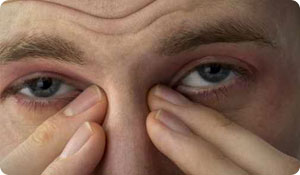
This common allergic condition, which according to the American Academy of Allergy, Asthma and Immunology affects about 20 percent of all Americans1sup>, actually doesn’t have anything to do with a fever or with hay. Rumor has it that the name simply originated when farm workers experienced seasonal allergies while out in the field during haying season.
And while many people with hay fever suffer from the symptoms mainly during the warmer months when everything is in bloom, some unlucky hay fever sufferers feel the effects throughout the entire year.
The Cause
Hay fever is the same thing as allergic rhinitis, which is an allergy that affects the nose and causes a range of nasal-related discomforts. Some of the common causes of hay fever are airborne seasonal allergens, with pollen being one of the largest offenders. This is particularly prominent in the spring when plants and flowers come into bloom. Other allergens that can travel by air and can make people sick include mold spores, dust and animal hair and dander.
Some people with allergies find that their symptoms are worse on hot, dry and windy days, when some of their allergens are especially prominent in the air. Rainy days can sometimes offer relief, on the other hand, since the allergens are “washed” out of the air.
Common Symptoms
There are a variety of symptoms that are typically caused by hay fever. These can include:
- Nasal congestion
- Sneezing
- Itchy ears, nose and throat
- Red, irritated or watery eyes2
- Post nasal drip, often with a cough
Recognizing an Allergy
If you suffer from hay fever, you may find yourself feeling much as you do when you have a cold. But if you pay attention, there are a few significant differences. First, allergies are worse during certain months (typically from spring to fall) and with constant exposure to your triggers (the allergen that sets off your allergic reaction), you will find your symptoms remaining consistent. With a cold, however, you typically will feel the symptoms progress, starting small, worsening, and then getting better all within a week or two time span.
With an allergy, you can often get relief by taking a shower to wash allergens out of your hair, closing your windows to block out pollen and running the air conditioner to filter particles from the air. In addition, allergies can often make you feel very tired.
Other differences can include clear mucus with allergies, while with colds and infections you can find the mucus may appear yellow or green. Finally, allergies usually don’t cause a fever, but a cold can be accompanied by one.
Rely on Trial and Error
If you think you may have hay fever but aren’t sure, try to become aware of when your symptoms appear. If you have allergies, chances are you will notice some patterns that repeat every year. You can also try minimizing your exposure to outdoor settings for a few days and notice if some of the symptoms go away. You can also try taking an antihistamine and see if this offers any relief. Finally, talk to your doctor about your questions and find out if allergy testing may be a good option to narrow in on some of your triggers so you can come up with most effective treatment plan.
Poll Question:
Can you tell the difference between hay fever and a cold?
- I always know the difference because I get the same symptoms at the same time every year.
- I can often differentiate, but not always, since the symptoms are awfully similar and hard to tell apart.
- I am never sure what causes my symptoms -- germs or allergies -- and therefore usually don’t know how best to treat them.
- I can’t tell the difference at all between allergies and a cold, but just know that I experience nasal symptoms frequently.





